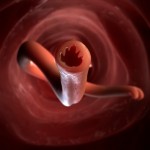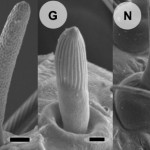
O-Buoy #7 captures a shot of a polar bear. (Courtesy of Todd Valentic and http://obuoy.datatransport.org/)
A version of this post can be found at the AGU GeoSpace blog.
The polar vortex dropped the jet stream and made large parts of the country miserable this year with freezing cold Arctic air. But, air temperatures over much of the Arctic were above average, and climate change continues to march on.
The Arctic sea ice grew slower than average this year, and the yearly ice cover is changing from a thick permanent layer to thinner seasonal sheets that break up in the summer.
This shift is altering the chemistry of the air over the Arctic, and may affect the climate in ways that scientists don’t yet understand.
To create better models of climate change that account for the changes in ice cover, researchers need to account for certain trace gases in the Arctic atmosphere. One such gas, bromine monoxide, comes from sea ice and can destroy ozone, which plays a role in regulating the concentrations of greenhouse gases. But how do scientists get these measurements from isolated, shifting ice floes?
Enter the O-Buoy. (Get it?! It sounds like “O Boy!”)
“It’s basically a chemistry lab in a buoy,” says Todd Valentic, an engineer who helped to develop the O-Buoy at SRI International, a non-profit research company in Menlo Park, California. The company is often on the cutting edge of technology, having received the first email message in 1969 and developed the software for SIRI, the voice of the iPhone’s digital personal assistant.
“Buoys in the Arctic are a great way of getting year-round sampling,” says Valentic , who presented research about the buoys at the American Geophysical Union’s Fall Meeting in December.
Field stations can only monitor from one point on land, and field camps on the ice usually only last for a few weeks. But the O-Buoy can keep chugging out data year-round from the uninhabitable Arctic Circle.
Data from the O-Buoys offer a way to study the interaction of gases present in tiny, yet important amounts in the atmosphere. They also give climate scientists a year-round picture of how the sea ice is shifting at the poles, where climate change has hit the planet hardest.
The O-Buoy has an eight-foot hull that, once inserted through the ice, floats in the seawater. The hull contains instruments to detect the trace gases of interest to researchers: ozone, a sharp-smelling gas that blocks harmful UV light when it’s high above in the ozone layer, but at the earth’s surface is the main ingredient in smog; carbon dioxide, the best-known greenhouse gas, and bromine monoxide, a gas that forms when bromine in seawater reacts with ozone.
 These gases are likely playing an interconnected role in the atmospheric chemistry of the Arctic.
These gases are likely playing an interconnected role in the atmospheric chemistry of the Arctic.
Each spring when the sun returns after the long, dark Arctic winter, the light helps to catalyze a cyclical reaction between the bromine salts in the ice and low-lying ozone in the air, called a “bromine explosion”. The bromine splits the ozone to create oxygen and bromine monoxide. The bromine monoxide molecules then react to create bromine and oxygen, and the newly created bromine molecule starts the cycle all over again. The cycle continues until the ozone is depleted.
The bromine explosion brings the surface ozone level down to almost zero for days at a time. Though ozone is toxic to animals and plants, its presence is important because it regulates the concentrations of other trace gases in the atmosphere, such as mercury and carbon dioxide. Since younger sea ice holds more bromine than older ice, the loss of permanent ice cover due to climate change may be creating more bromine explosions. Without ozone to regulate it, toxic mercury from higher altitudes could find its way down to the surface and into ocean food chains, according to a recent study published in Nature by Moore et. al.
To create and deploy the O-Buoys that monitor these gases, Valentic works in collaboration with several researchers, including the lead scientist, Paty Matrai at Bigelow Laboratory for Ocean Sciences in Boothbay, Maine, and the National Science Foundation Arctic Research Support and Logistics Program.
The movement of the buoys can be tracked on the O-Buoy website. Arctic winds create a current called the Beaufort Gyre, which drive the buoys in a clockwise rotation. Another current called the Transpolar Drift Stream shoots the buoys out the Fram Strait, just east of Greenland.
A six-foot mast on the O-Buoy rises into the air to hold weather monitors and a communications antenna. Each day the O-Buoy sends data back to the lab via satellite. Solar panels power rechargeable batteries during the summer, and lithium batteries keep the buoy going throughout the dark winter. The instrument functions for about one year before the batteries run out, and then it bobs around in the ocean, or sits in the ice until a passing icebreaker can collect it.
The O-Buoys are also each equipped with a camera, which takes a photo every 20 minutes.
“It’s basically a webcam, like you’d use for Skype,” says Valentic.
He says that at first the camera was just a novelty, but once they posted the time-lapse videos online, they generated a lot of interest, especially from students. It didn’t hurt that the cameras captured two images of curious polar bears. (Check out O-Buoy #2 to see the summer sea ice melt and shift.)
SRI is currently building four more O-Buoys, which will head to Antarctic sites where “it’s hard to put a weather station,” Valentic says. The buoys’ instruments will measure sea ice thickness and monitor the temperature and weather.







Comments are closed.